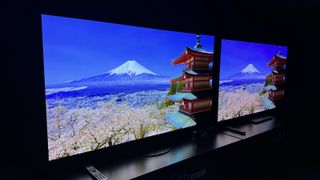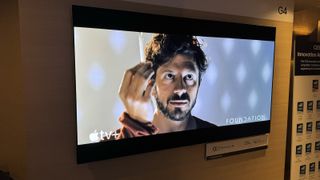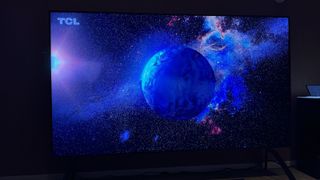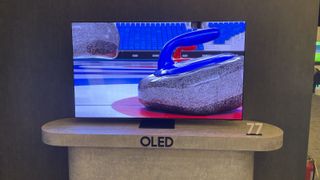While hi-fi and home cinema devices are certainly announced at CES, it is undeniably primarily a show about TVs. Having trawled the halls over several days, I’m pretty sure I saw every new TV at CES 2024 – though it is possible that an obscure model from an equally obscure brand slipped through the net.
Of course, every demo I saw at CES was brief and limited, and we won’t be delivering our verdicts on any of the new models until we’ve had them into our test rooms for comprehensive and comparative reviews, but these are the TVs that I left the show most impressed with and excited about.
Panasonic Z95A

Panasonic’s replacement for the excellent MZ2000 is the Z95A, which features a second-generation MLA OLED panel, more advanced processing and a new heat management system for even greater brightness. Panasonic has also switched from its own My Home Screen OS to Amazon’s Fire OS – an excellent move that significantly boosts app support.
In action, the Z95A appears to be everything we could hope for: the cinematically authentic picture quality for which Panasonic is rightly renowned with an extra injection of pop, solidity and impact thanks to that additional brightness. It's just a shame that it's only available in 55- and 65-inch sizes, with the 77-inch version being the non-MLA Z93A.
Read the full Panasonic Z95A hands-on
LG G4

Much of the CES attention has been on LG’s transparent OLED T and wireless M4 TVs, but while both are very impressive in their own ways, it’s the new G4 that I was most drawn to on a visit to LG’s demo suite in Vegas.
I wasn’t actually expecting to be that impressed by the G4, seeing as it looks the same as the G3 and initially seems very similar on paper but, like the Panasonic Z95A above, it features a second-generation MLA OLED panel for even greater brightness and ‘pop’ than before. What’s more, the 83-inch model is the first TV its size to have MLA tech and it looks absolutely incredible in action.
Read the full LG G4 hands-on
Hisense ULED X

On the subject of very large TVs, Hisense went big on its 110-inch ULED X at CES, and I was much more impressed with it than I expected. The numbers associated with it are ridiculous – 40,000 dimming zones and 10,000 nits of brightness – but I’ve been reviewing TVs long enough to know that big numbers don’t always equate to a big performance.
The ULED X looked dazzling on Hisense’s stand, though. Brilliantly bright but also surprisingly controlled and balanced, with awesome contrast and pin-sharp definition. I suspect it will also be monstrously expensive (no pricing has yet been announced) but I’m very much hoping to fully test the 110-inch ULED X at some point.
TCL QM891G

The Hisense ULED X wasn’t even the biggest TV I saw at CES – that honour belongs to the 115-inch TCL QM891G. It has half as many dimming zones (20,000) and half as much brightness (5000 nits) as the ULED X, but these are still huge numbers by general TV standards and it looked thrillingly punchy in action.
Blacks looked very deep during the demo and despite some really high-contrast images being shown on the TV, there was no visible blooming around those super-bright highlights. I think anyone considering building a dedicated home cinema room would be wise to consider this TCL rather than a projector – although the price is expected to be just shy of £20,000 / $20,000.
Samsung S95D

At CES, Samsung was more focused on its 8K QN900D Mini LED model than the S95D QD-OLED, but it was the latter that I was most impressed with. It features a third-generation QD-OLED panel that goes significantly brighter than its predecessor, plus a new anti-glare layer that massively reduces reflections.
In action, it looked super-bright and vibrant, and a test involving a spotlight being shone directly at the display proved that the new coating works a charm in reducing those unwanted reflections. It will be fascinating to put the S95D up against the LG G4 and Panasonic Z95A once final samples are available.
MORE:
These are the best TVs you can buy right now
Catch up on all the news from CES 2024

